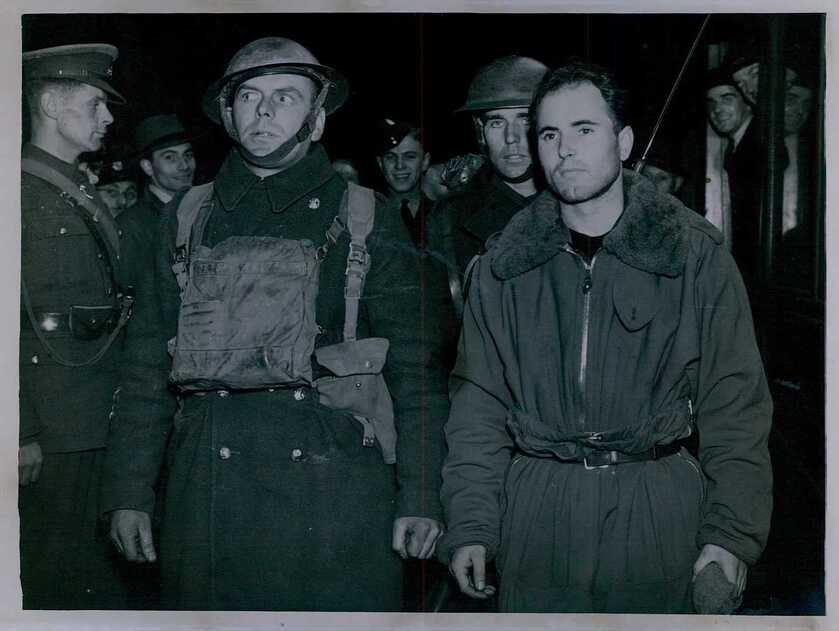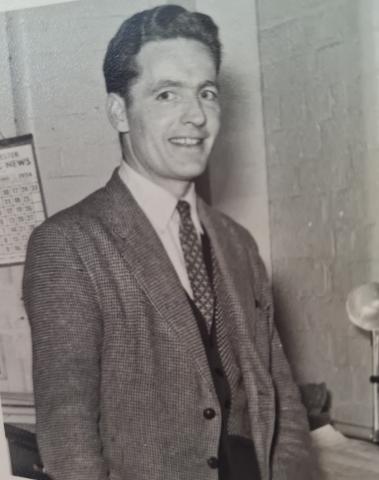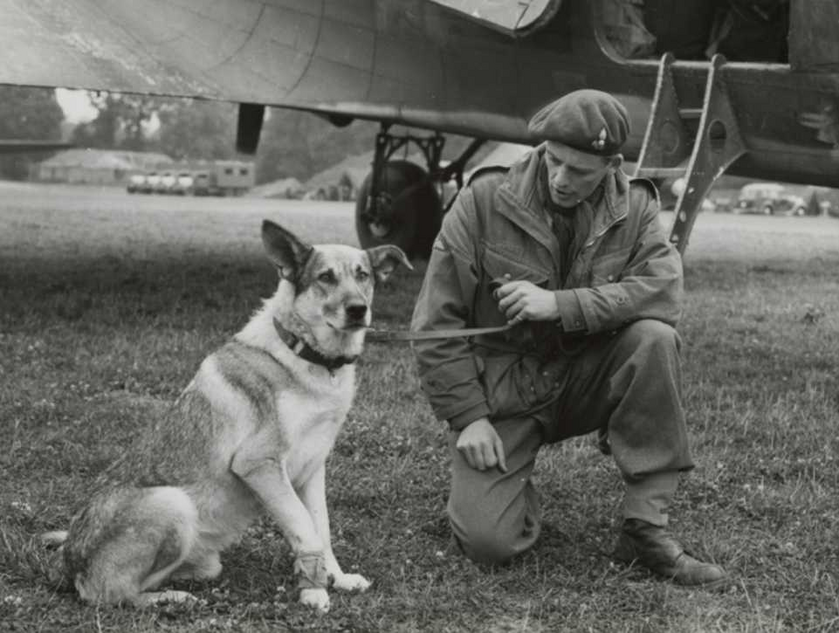Trained at Bulford, Ringway, Hardwick Hall, encompassing Parachute Regiment, Glider Pilot Regiment & RAF 38 & 46 Group.
Hoping to put up items of interest for researchers or those with family links to the division.
Looking to post collation of World War II photos, articles, books and booklets & any other history related topics.
S/Sgt. Henry ‘Harry’ Howard. Served in Sicily, Italy & Normandy before being taken prisoner at Arnhem, where he served with 15 Flight, ‘F’ Squadron, The Glider Pilot Regiment. A 1st Pilot, the photo is taken whilst serving in the Mediterranean theatre of operations. 1943.
"At the time of D-Day I was a S/Sgt Pilot in F Squadron of the Glider Pilot Regiment, based at Broadwell RAF Station near Burford in Oxfordshire, having returned from glider operations in the Mediterranean earlier that year... Below is my account of what happened to me on the evening of D-Day, and to the 26 members of {Lieutenant} Paddy Devlin's {No.1} platoon {"C" Company, 1st Battalion The Royal Ulster Rifles} who were on board my Horsa glider, which was towed by a Dakota, or, as you will read, two Dakota tugs.
I was a Staff Sgt first pilot in 15 Flight, F Squadron of the Glider Pilot Regiment, and my second pilot was Sgt. Holman with whom I had only flown for twenty minutes prior to Operation Mallard, which was a landing on the evening of D-Day to reinforce the earlier airborne operations which took place in the very early hours of 6th June. Sixth Airborne Division were untried in battle, but, like everyone else who had trained and trained again for the invasion, we were raring to go. I recall the briefing, the maps and photographs of the approach along the River Orne and Caen Canal to the landing zone near Ranville, and the gaiety of the Royal Ulster Riflemen who filed aboard my glider.
Soon came take-off; I had gained sufficient speed on tow behind my Dakota tug to lift the glider off the runway to a position just above the tug's slip-stream; we were over half-way down the airfield when to my horror, because the tug was still on the deck, its undercarriage started to rise and the aircraft bellied on to the runway with sparks flying everywhere. I realised immediately that it could not become airborne and my speed was carrying me over and past the tug. There was still some runway ahead of me, so I released the tow rope, applied full flaps and touched down beyond the tug which I saw as I passed over it, had fortunately slewed to starboard on to the grass verge. This meant the runway was still clear for further combinations to take off, provided of course that I did not block it with my aircraft. Although the Horsa was equipped with a skid which was designed for landing in a shorter distance than would be possible with the undercarriage, we had long learned to keep the wheels intact and not jettison them after take-off. They were fitted with hydraulic brakes which meant that upon touching down the glider could be steered left or right for a distance if there was an obstruction straight ahead. The skid method gave no such choice and the braking system was almost as effective in distance travelled before stopping. I dared not apply brakes and rudder too quickly in case we ground looped and came to grief. The perimeter fence was looming up very quickly but fortunately I turned left off the runway and came to rest near the perimeter track. You can imagine the Irish comment which came back to me from the strapped-in platoon in the main fuselage. I think we all felt both relief and disappointment, but no sooner had my co-pilot and I taken full stock of the situation than we heard the roar of one of the station tractors and before we could fully realise it, we were hitched up, taken back to the start line about two miles round the perimeter track and coupled to one of the reserve tugs.
Meantime the full stream from Broadwell had taken off, but by cutting the corners while the whole air armada of some 250 gliders with their tugs, was forming up over southern England, I found myself back. Impressions of the immense amount of shipping; the spot-on approach to the Landing Zone by my new tug crew; their message of good luck over the tow-rope inter-com before I cast off for the landing; the concentration involved in watching airspeed, avoiding other gliders on the final circuit, and choosing the most open landing space amongst the haphazard array of gliders and obstacle posts on the ground; and the hope that the German ack-ack fire together with their mortar barrage on the ground would miss us - these impressions were certainly noted, but somehow seemed of little consequence compared with the excitement - for me at least - of the original take-off. We pilots were not expendable, unlike our gliders, and after digging in for the night (it was now 9pm) in a wood bordering the LZ and standing to on D + 1 for the counter attack which never came in my sector, we were relieved by Lord Lovat's Commando amongst other seaborne troops, and apart from being sniped at by a lone German in a church tower we eventually found our way back to the coast at Ouistreham where we were taken aboard a landing craft and returned safely to England for debriefing and preparation for a further flight of reserves if the invasion had gone sadly wrong. I was proud to have been in the vanguard on D-Day, and perhaps I was lucky that, because of the superb training and organisation for that fateful day, matters went so well for me, that my 24 hours of action could well have been one of the several practice operations which preceded D-Day, and which, when one remembers the chaos of some of those, were probably just as dangerous as the real thing."

Charle's Wheeler's D-Day: Turning The Tide (1994)
Part I
Major Howard
Wally Parr
Bill Gray
Sgt. Leonard Daniels,
Lt-Col. Otway
Sgt. Sid Knight
Major-General Gale, the Division's commander, addresses Divisional troops at Harwell aerodrome.
Airborne sappers place detonators into shrapnel mines.
Military Policemen attend to their Matchless and Enfield motorcycles.
An Airborne signals lieutenant and private paint the Liberation star on a cloth panel. A corporal performs a 'native' dance for off-duty signallers.
Signallers check jeep-mounted radio equipment. Engineers pack PIATs and ammunition into a parachute container. Parachute Regiment troops are issued with two 24-hour compo ration boxes, etc.
Men from the 2nd Battalion, the Oxford and Buckinghamshire Light Infantry, support platoon load ammunition and a Vickers machine gun into jeep trailers. A mechanic services a jeep.
Weapons such as a Lee-Enfield rifle, a Colt .45 automatic pistol, a Mark 5 Sten gun, a Bren gun and Nos 36 and 69 grenades are examined before being packed.
Empty Bren and Sten magazines are loaded with bullets and packed into boxes.
Airborne ...
ASSAULT UNITS PREPARE FOR THE INVASION OF EUROPE (PART 7) (Imperial War Museums)
Filmed by Sgt. L. Harris, No. 5 AFPU showing pathfinders from 22nd Independent Parachute Company and men of 2nd Bn (Airborne) OXfordshire & Buckinghamshire Light Infantry playing cricket
Loading up of Horsa gliders and parachute containers filmed at Harwell and Tarrant Rushton
Brittany Ferries Historic Talking Tours The Pegasus Trail An Account of the Operations of the 6th Airborne Division in Normandy 6th June – 17th August 1944
Not the best quality recording as this was not a transfer but a basic recording
SIDE 1
Italian airmen who were taken prisoner after their planes had been shot down over England yesterday passed through Londin this afternoon on their way to the Prisoners Camp 12th November 1940.

When a Douglas C47 Dakota aircraft of RAF Transport Command returned from France, one of the passengers was a German war dog which was wounded by men of the 6th Airborne Division when they stormed Ranville North East of Caen. The dog, named Fritz, had apparently been trained to attack anyone with firearms. It was wounded in the leg and taken behind the line where it received first aid treatment from a British Army unit before being flown to England in charge of parachutist Major Philip Wilfred Varvill.
When the Royal Australian Air Force photographer was photographing Fritz, the dog apparently thought the camera was a firearm and attempted to leap at the photographer. Fritz will be sent to do a course at a British War Dogs school when he has recovered from his wound.
This image was shot for the Daily Mail newspaper but was also reported in Australian papers.
Cpl. John Williamson, 12th Parachute Battalion taken prisoner Normandy 18th August 1944 probably captured during a night raid on Putot-En-Auge.
12th Parachute Battalion War Diary
18th August 1944 Place: Mongassard
0450 - Bn advanced through TROARN to MON GASSARD 192690 as reserve Bn to 5 Para Bde and awaits orders to continue advance. Capt J.A.N. Sim, Lieuts J.H. Duthie, Hall, Warren and Flint and 80 ORs joined from U.K. C Coy formed under Capt Sim.















